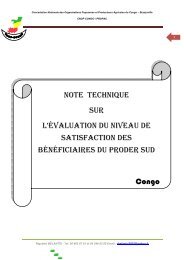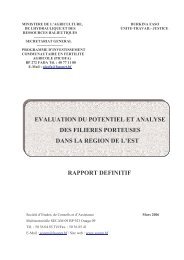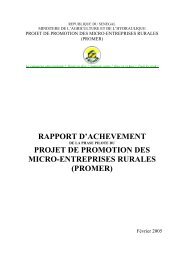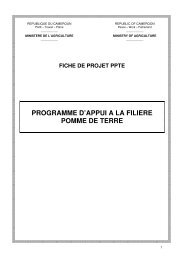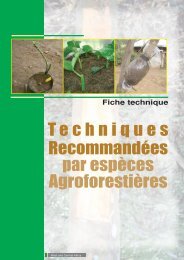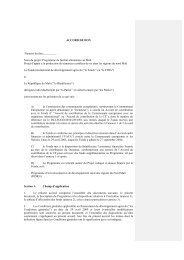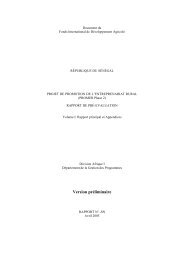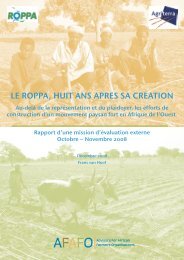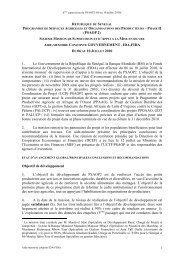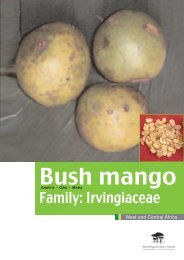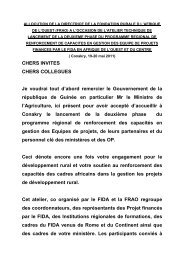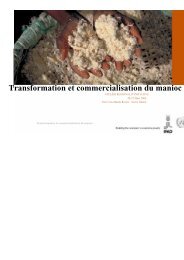Scaling Up the Fight Against Rural Poverty - FIDAfrique
Scaling Up the Fight Against Rural Poverty - FIDAfrique
Scaling Up the Fight Against Rural Poverty - FIDAfrique
You also want an ePaper? Increase the reach of your titles
YUMPU automatically turns print PDFs into web optimized ePapers that Google loves.
In smaller countries IFAD has been moving towards national approaches (e.g., Ghana, <strong>the</strong> Dominican<br />
Republic and Moldova). This allows a broader-gauged impact and engagement in <strong>the</strong> national policy<br />
and institutional debates. But it also creates potential tensions between IFAD’s traditional corporate<br />
goal to focus on <strong>the</strong> rural poor and work with rural communities on <strong>the</strong> ground, and <strong>the</strong> need to engage<br />
in capital city-based program design and implementation, as well as policy analysis and dialogue.<br />
Regional trans-border approaches are ano<strong>the</strong>r way for IFAD to scale up its impact. So far regional<br />
approaches have tended to involve projects that support regional knowledge dissemination, agenda<br />
setting and institution building, as was <strong>the</strong> case in two examples for Latin America (<strong>the</strong> Regional<br />
Family Farming Fund, and <strong>the</strong> <strong>Rural</strong> Regional Dialogue Programme). An alternative is to engage in<br />
regional investment lending. This is more complicated for IFAD, since it has to work with<br />
governments and sovereign guarantees. Moreover, since rural development generally does not involve<br />
<strong>the</strong> provision of regional public goods or regional infrastructure, regional programs will generally not<br />
be necessary. However, it could be a relevant approach where <strong>the</strong>re is significant potential for regional<br />
value chains involving producers with cross-border backward and forward linkages.<br />
2. Partnerships with joint financing – Cofinancing and SWAps<br />
Since IFAD is a relatively small donor, scaling up will usually involve forming partnerships with o<strong>the</strong>r<br />
actors. Partnerships may be temporary and not involve any joint financing of projects and programs, as<br />
in cases where IFAD hands off an initiative to ano<strong>the</strong>r national or international partner who is to take<br />
over <strong>the</strong> responsibility for sustaining and expanding <strong>the</strong> program piloted by IFAD. Even such<br />
partnerships require early attention and effective management to ensure a successful hand-off.<br />
More structured are <strong>the</strong> traditional co-financing approaches that bring toge<strong>the</strong>r two or more donors in<br />
funding a particular project. Commonly <strong>the</strong>se arrangements involve parallel funding of components of<br />
a single project, ra<strong>the</strong>r than joint funding of <strong>the</strong> overall project. IFAD has expanded in recent years its<br />
use of such cofinancing mechanisms. 33 However, cofinancing tends to increase transactions costs and<br />
uncertainties, due to <strong>the</strong> different operational practices and varying commitments of <strong>the</strong> donor<br />
partners. 34 A recent joint evaluation of <strong>the</strong> IFAD-AfDB partnership arrangements confirmed this<br />
conclusion. (African Development Bank and IFAD 2009) Also, while cofinancing allows a larger scale<br />
of funding for any given project, it does not necessarily mean that <strong>the</strong> project is itself designed and<br />
implemented as part of scaling up pathway. In <strong>the</strong> absence of institutional mandates for scaling up,<br />
cofinanced projects are more likely to be stand-alone interventions that do not lead to greater scale<br />
impact beyond <strong>the</strong> project itself.<br />
IFAD has also participated in Sector-wide Approaches (SWAps), under which donors coordinate <strong>the</strong>ir<br />
activities and may also combine <strong>the</strong>ir funding in a common pool (“basket”) in support of a<br />
government’s sectoral expenditure program. 35 However, IFAD has serious concerns whe<strong>the</strong>r it can<br />
33 See for example, IFAD, “Report on IFAD’s Development Effectiveness”, EB 2009/98/R.10/Rev.1, 15<br />
December 2009; IFAD, “Portfolio Performance Report, Western and Central Africa Division”, July 2007-June<br />
2008<br />
34 IFAD, ARRI 2009; IFAD, ARRI 2008; IFAD, “Portfolio Performance Report, Western and Central Africa<br />
Division”, July 2007-June 2008. The fact that IFAD is willing to adopt <strong>the</strong> fiduciary processes and standards of<br />
its cofinanciers is a significant positive factor.<br />
35 IFAD has participated in four SWAps: Tanzania, Mozambique, Uganda and Rwanda. IFAD had also intended<br />
to participate in a SWAp in Nicaragua, but this did not materialize. IFAD expects future additional agricultural<br />
SWAps in Kenya and possibly Malawi and Zambia.<br />
40



